I wanted to start this blog by explaining a method of hanging drywall that can make a building more energy efficient. It is easy f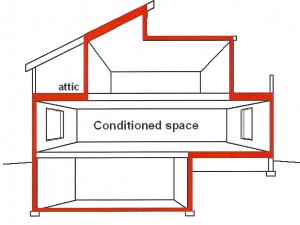 or a drywall contractor to become more involved in the building performance mania. Myron R. Ferguson
or a drywall contractor to become more involved in the building performance mania. Myron R. Ferguson
It turns out that one way to create a more energy efficient building is to have a good air barrier at the thermal boundary (building envelope). The building envelope separates the conditioned (heated or cooled spaces) from unconditioned spaces (outdoors, attics, and the ground). The building envelope is quite often right where the drywall is installed.
Why do we want to stop air from entering walls and ceilings? To prevent wasting energy. If heated or cooled air is allowed
to escape through gaps and holes in the building envelope then energy is being wasted. Also escaping air can carry moisture that could condense in walls or attics which then can cause mold and rot.
To create a good air barrier, the drywall has to be attached to the framing in an airtight manner and all possible air leakage points around holes cut into the drywall have to be properly sealed. The combination of the drywall, framing, caulks, and sealants make up the air barrier assembly.A sheet of drywall as a material is a good air barrier. But as you know it is not very often that a piece of drywall is hung that is not cut full of holes (electrical boxes, ductwork windows and doors and etc.) .
Holes in drywall on exterior wall for oulets & swithces
Before the drywall is hung some sealing of electrical boxes and similar protrusions will have to be done. Some simple caulking and sealing of holes in the boxes is an easy way to seal but for a much tighter seal isolating the boxes is a better idea. Foam or clay products can be used to form an airtight cover around the box.When the drywall is attached and cut around the opening, the potential leakage point is sealed with adhesive or caulk.
Energy Block around electrical box
Isolating protrusions in ceilings is even more important than in a wall because of the stack effect in a building . The stack effect refers to the draft established in a building from air entering low and exiting high. 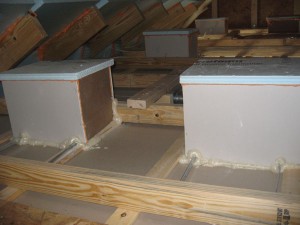
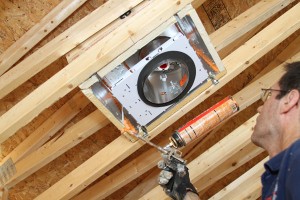
Insulated boxes for can recessed lights in attic. Applying foam to seal gaps before covering with drywall.
Drywall adhesive is quite often used when attaching drywall to help eliminate fastener pops. Drywall adhesive can be used to air seal all edges of the panels. If instead of just applying the adhesive along the center of the panels the adhesive is also applied along the perimeter of each wall and also around the framing of window and door openings. A flexible caulking or an acoustical sealant would be a better choice because of the flexing and stretching characteristics, but I know for most drywall contactors the adhesive would be their first choice because of the convenience. Just make sure the bead is continuance and about a 3/8-inch thick bead.
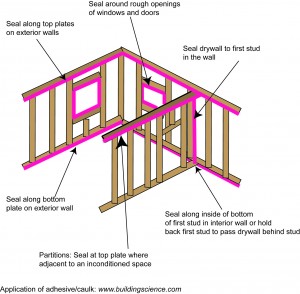
Because of the way ceilings are constructed it is difficult to seal the perimeter of the drywall with adhesive or caulking. If the walls are properly sealed around the perimeter then air should not be able to find its way along the ceiling edges. But because I believe in being extra thorough I suggest sealing the perimeter of the ceiling. Where walls and ceilings intersect expanding foam can be used to seal in gaps. This can be done from up above in the unconditioned attic or from below after the ceiling is hung but before the walls are butted up to the ceilings.
Air sealed ceiling edges in attic- scarp drywall was used in conjunction with the foam
We all need to be more energy conscious, and yes it does take extra time and attention to detail to properly air seal a building. By helping the customer understand the concept it really is a win -win situation. The key point is that the architect, owner, builder, and hopefully with the help of a certified green verifier all need to work together. The process can be very easy and rewarding for a long time.
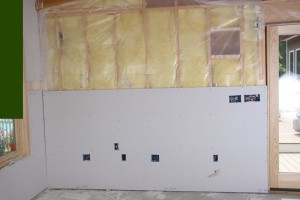
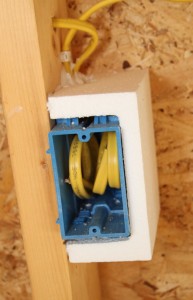
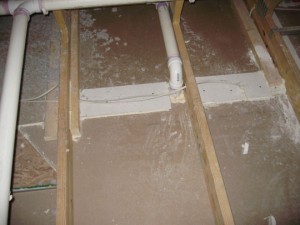
Do you have a manufacturer for those foam electrical box covers?
It is Energy Block. http://www.energyblock.com
Your blog starts out ok, (with the exception of the top floor ceiling drywall) then you proceed to go in the wrong direction by thinking that it is the drywall that should be air tight. You are completely sacrificing the insulation r-value with this method, the exterior surface of the structure need to be air tight not the drywall.
The air barrier can be on the outside of the building envelope, in the center of the envelope assembly or on the inside of the envelope as long as it is located at the same location as the insulation
Sounds like you are concerned about outside air entering the walls or ceiling and reducing the R value by what is called wind washing. Fiberglass insulation works by trapping air so if air travels through it for any reason it can reduce the R value.
The exterior of the envelope is a relatively easy place to locate the air barrier because the are a lot less penetrations like outlets and heat ducts, so an air barrier is commonly locate along the outside of the envelope
My article focused on the interior air barrier (yes you can have more than one air barrier). The idea is to stop air from entering the walls and ceilings from the interior and to prevent air from moving through because of a missed area on the exterior barrier. There are many pathways that air can travel through if it enters a wall through an outlet for example the air can end up in the attic. Ceiling are especially leaky because there are a lot of holes cut into ceilings and because of the stack effect a lot of air often gets through these holes.
I have never been in an attic where there was an air barrier installed over the insulation so preventing wind washing along the vented soffits and installing airtight drywall will help keep the insulation at its proper R value.
An invention that may solve this problem has hit the market called Box Shell. http://www.JBOXSHELL.com
It is a simple cardboard form that is stapled around an outlet box to the framing – and then after the wall board is installed, spray foam is squirted in between the Box Shell and the outlet box. The foam creates an air tight seal. It is really inexpensive and fast. We put them on the outlets in our interior sound walls as well. They just work.
I think it is a good idea. I have been using a similar product for years. The only thing I am not crazy about is using the expanding foam after the drywall is hung and especially after the electrical outlet/switch. Could create a mess on the drywall face and the electric is obvious. Why not foam before the drywall is hung?
Myron